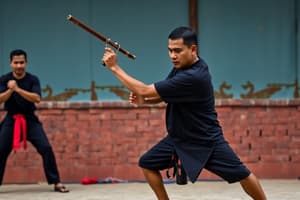Podcast
Questions and Answers
What is Arnis known as in the Philippines?
What is Arnis known as in the Philippines?
The official national sport and martial art of the Philippines
Which of the following terms is associated with Arnis?
Which of the following terms is associated with Arnis?
- Karate
- Taekwondo
- Kali (correct)
- Eskrima (correct)
Arnis is mainly practiced by scholars in the Philippines.
Arnis is mainly practiced by scholars in the Philippines.
False (B)
What does the term 'arnes' mean in Spanish?
What does the term 'arnes' mean in Spanish?
Arnis is a ____ based martial art.
Arnis is a ____ based martial art.
In what century did Spanish fencing influence Arnis?
In what century did Spanish fencing influence Arnis?
Match the following Filipino terms related to Arnis with their meanings:
Match the following Filipino terms related to Arnis with their meanings:
What are some materials used in body armor for Arnis?
What are some materials used in body armor for Arnis?
Which organization was founded in 1975 for Arnis in the Philippines?
Which organization was founded in 1975 for Arnis in the Philippines?
What is the role of Arnis during the Philippine revolution?
What is the role of Arnis during the Philippine revolution?
Flashcards are hidden until you start studying
Study Notes
Overview of Arnis
- Arnis is the national martial art and sport of the Philippines, also known as Kali or Eskrima.
- Focuses on weapon-based fighting, utilizing knives, sticks, bladed weapons, and improvised tools.
- Includes hand-to-hand combat, grappling, and weapon disarming techniques.
Historical Context
- Arnis emerged from native fighting techniques used in conflicts among pre-Hispanic Filipino tribes.
- Influenced by Spanish fencing from the 15th century, along with Chinese, Arab, and Indian martial arts.
- The sport started among peasants and commoners; lacked written records due to limited scholarly knowledge.
Etymology of Terms
- The term "Arnis" derives from the Spanish word "arnés," meaning armor.
- "Eskrima" is adapted from the Spanish "esgrima," which translates to fencing.
- "Kali" is believed to originate from the pre-Hispanic term "kalis," referring to blades.
Cultural Influences and Connections
- Some beliefs associate Arnis with Indian martial arts, particularly Silambam from Tamil Nadu, due to historical trade and travel connections.
- Arnis shares similarities with Silambam's techniques involving short sticks and other weapon styles.
Development and Expansion
- Originally practiced in the Philippines, Arnis has spread globally, especially during and after World War II.
- Significant for its role in the Philippine revolution against Spanish colonization.
Governing Organizations
- National Arnis Association of the Philippines (NARAPHIL), founded in 1975 by Gen. Fabian C. Ver.
- World Eskrima Kali Arnis Federation (WEKAF), established in 1989 under SGM Dionisio Canete.
- Arnis Philippines System (ARPI), founded in 1986.
Edged Weapons
- Edged weapons such as knives, daggers, and spears have been historically significant for combat, hunting, and ceremonial purposes.
Body Armor
- Specially designed body armor provides upper body protection against head strikes, employing materials like leatherette and vinyl printed with ethnic art.
Studying That Suits You
Use AI to generate personalized quizzes and flashcards to suit your learning preferences.




